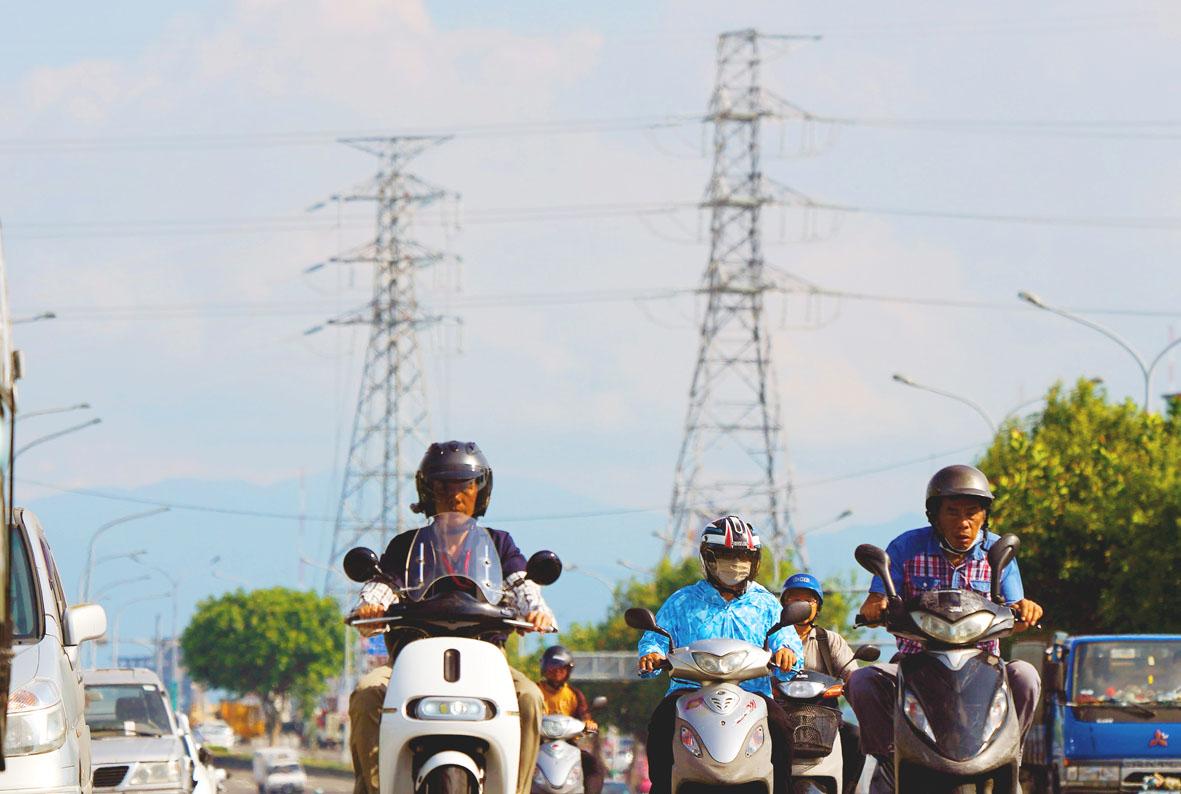Record heat is bringing record electricity use this month, after peak electricity consumption yesterday broke all historical records, Taiwan Power Co (Taipower, 台電) said.
As the mercury spiked close to 39°C, Taiwan’s electricity consumption reached as high as 37.79 gigawatts (GW) at 1:59pm yesterday, higher than the previous record of 37.53GW, seen just a day prior, the state-run utility said.
The top 10 peak consumption records have all occurred in the past three years, Taipower said.

Photo: CNA
As the high temperatures are likely to continue this summer, more records might be set, it said.
However, Taipower assured people that there is so far no need to worry about electricity shortages, despite the record-breaking demand, Taipower manager Chang Ting-shu (張廷抒) said.
“Our operating reserve margin is still 10.38 percent,” Chang told the Taipei Times by telephone, referring to the company’s “green” indicator.
The operating reserve margin is the amount of additional power that can be drawn from operational power plants to meet electricity demand in case a generator goes offline.
Taipower uses a five-color warning system to reflect the stability of the nation’s power supply, with “green” denoting an operating reserve margin of 10 percent or above and suggesting that the nation has an adequate supply of electricity.
“Yellow” means that the operating reserve margin is 6 to 10 percent, while “orange” signals a reserve margin of below 6 percent, “red” indicates less than 900,000 kilowatts and “black” less than 500,000 kilowatts.
Taichung Power Plant’s controversial No. 2 coal-fired generator was yesterday running at full capacity, the company said.
“We could not have done without it [No. 2 generator],” Chang said, adding that without the generator’s contribution of 0.55GW of electricity, the operating reserve margin would have fallen below 10 percent.
The Taichung City Government late last month fined Taipower for restarting the No. 2 generator, but the fine was later revoked by the Environmental Protection Agency.
Chang credited solar power for generating 2.13GW of electricity during peak usage, when it was needed most, saying that it accounted for 5.5 percent of total peak usage yesterday.
“Of course, the hotter it gets, the more electricity we use,” he said. “Fortunately, that is also when we get the most electricity from solar power generation.”
Wind power generation is strongest in winter, he added.

Three experts in the high technology industry have said that US President Donald Trump’s pledge to impose higher tariffs on Taiwanese semiconductors is part of an effort to force Taiwan Semiconductor Manufacturing Co (TSMC, 台積電) to the negotiating table. In a speech to Republicans on Jan. 27, Trump said he intends to impose tariffs on Taiwan to bring chip production to the US. “The incentive is going to be they’re not going to want to pay a 25, 50 or even a 100 percent tax,” he said. Darson Chiu (邱達生), an economics professor at Taichung-based Tunghai University and director-general of

‘LEGACY CHIPS’: Chinese companies have dramatically increased mature chip production capacity, but the West’s drive for secure supply chains offers a lifeline for Taiwan When Powerchip Technology Corp (力晶科技) entered a deal with the eastern Chinese city of Hefei in 2015 to set up a new chip foundry, it hoped the move would help provide better access to the promising Chinese market. However, nine years later, that Chinese foundry, Nexchip Semiconductor Corp (合晶集成), has become one of its biggest rivals in the legacy chip space, leveraging steep discounts after Beijing’s localization call forced Powerchip to give up the once-lucrative business making integrated circuits for Chinese flat panels. Nexchip is among Chinese foundries quickly winning market share in the crucial US$56.3 billion industry of so-called legacy

Taiwan Semiconductor Manufacturing Co (TSMC, 台積電) yesterday held its first board of directors meeting in the US, at which it did not unveil any new US investments despite mounting tariff threats from US President Donald Trump. Trump has threatened to impose 100 percent tariffs on Taiwan-made chips, prompting market speculation that TSMC might consider boosting its chip capacity in the US or ramping up production of advanced chips such as those using a 2-nanometer technology process at its Arizona fabs ahead of schedule. Speculation also swirled that the chipmaker might consider building its own advanced packaging capacity in the US as part

A move by US President Donald Trump to slap a 25 percent tariff on all steel imports is expected to place Taiwan-made steel, which already has a 25 percent tariff, on an equal footing, the Taiwan Steel & Iron Industries Association said yesterday. Speaking with CNA, association chairman Hwang Chien-chih (黃建智) said such an equal footing is expected to boost Taiwan’s competitive edge against other countries in the US market, describing the tariffs as "positive" for Taiwanese steel exporters. On Monday, Trump signed two executive orders imposing the new metal tariffs on imported steel and aluminum with no exceptions and exemptions, effective